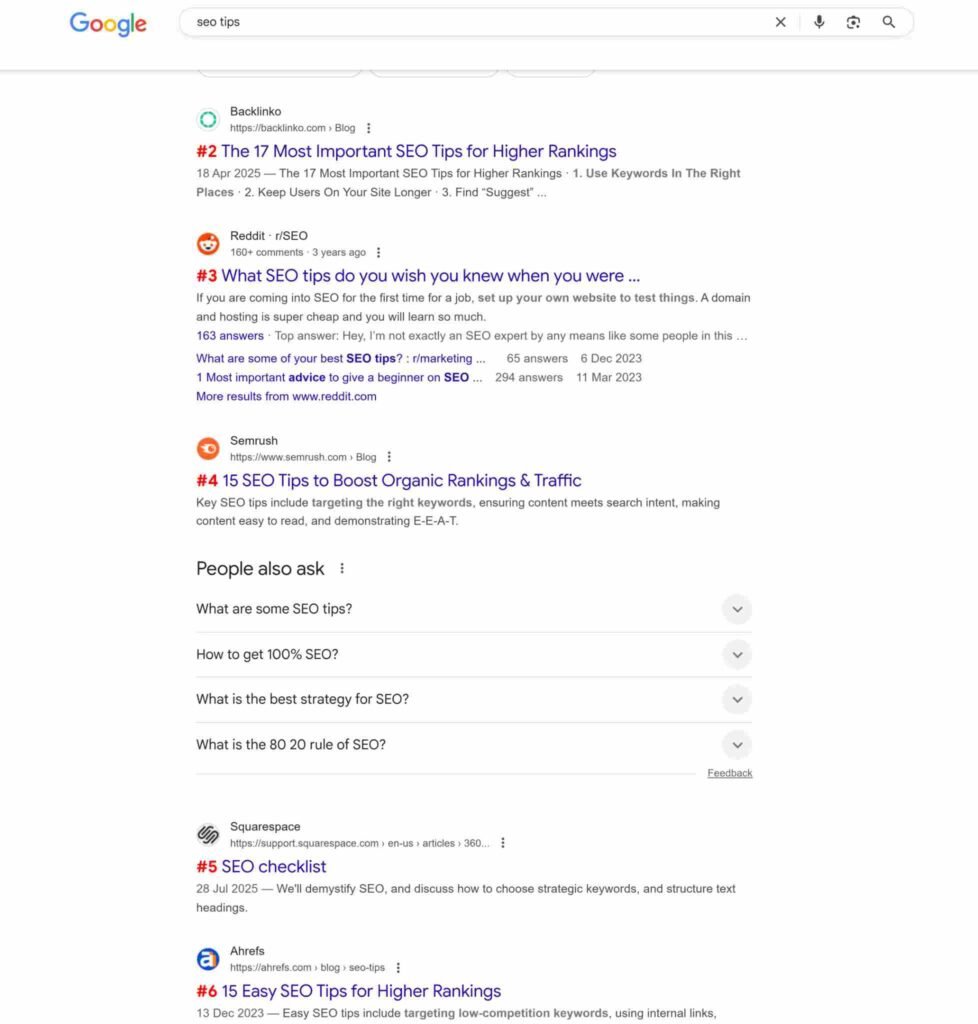Want your blog posts to actually get found in search results? We’ve all been there – spending hours crafting the perfect blog post only to watch it disappear into the internet void with zero traffic. The truth is, even amazing content needs proper SEO to be discovered. And that’s exactly why you need a reliable SEO checklist for blog posts.
Whether you’re a seasoned blogger or just starting out, this comprehensive guide will walk you through everything you need to optimize your blog posts for search engines. Plus, it’s designed to be actionable – you can apply these techniques to your very next post!
Ready to boost your blog’s visibility? Let’s dive into the essentials of blog SEO that actually work in 2023.
Pre-publish blog SEO checklist
Pick a high-impact focus keyword
Start by selecting a primary keyword that’s both relevant to your content and has decent search volume. Use tools like Google Keyword Planner, Semrush, or Ahrefs to identify terms people actually search for. Look for keywords with lower competition but good search volume – this sweet spot gives you the best chance to rank. Remember to check the search intent behind your chosen keyword to make sure it matches what your blog post will deliver.
Run a competitor post audit
Before writing, check out the top-ranking posts for your target keyword. Open the first 5 results and analyze what they’re doing right. Notice their content structure, word count, topics covered, and even how they format their headings. This isn’t about copying – it’s about understanding what Google already considers valuable for this topic. Identify content gaps you can fill and opportunities to create something even better than what’s currently ranking.
Create a clear and SEO-friendly URL
Your URL should be short, readable, and include your primary keyword. Avoid unnecessary words like “the,” “and,” or “of.” For instance, if your post is about “10 Ways to Improve Your Blog’s SEO,” a good URL would be: yourblog.com/improve-blog-seo. Keep URLs under 60 characters and use hyphens to separate words. This helps both users and search engines understand what your page is about at a glance.
Place the keyword in the title and H1 wisely

Include your primary keyword in your title tag (preferably near the beginning) and your H1 heading. However, don’t just stuff it in – it needs to read naturally. Your title should be compelling enough to drive clicks while clearly conveying what the post is about. Try to keep titles under 60 characters so they display fully in search results. Remember that your H1 can be slightly different from your title tag, giving you flexibility to optimize both for SEO and readability.
Craft a compelling meta description
Though not a direct ranking factor, your meta description affects click-through rates, which do impact rankings. Write a compelling 150-160 character summary that includes your primary keyword and gives searchers a reason to click. Think of it as ad copy – it should sell your content with a clear value proposition. Include a call-to-action like “Learn how,” “Discover,” or “Find out why” to encourage clicks.
Design your content to improve SEO
Use headers to break the blog structure
Headers (H2, H3, H4) help search engines understand your content hierarchy and improve readability for users. Create a logical structure with your primary keyword in at least one H2 and include secondary keywords in other headers where they fit naturally. Think of headers as signposts that guide readers through your content. Each section should focus on one specific aspect of your overall topic, making your post easier to skim and digest.
Add key phrases in the first 100 words
Search engines give more weight to content near the top of your post, so include your primary keyword in the first 100 words. But don’t stop there – also introduce what readers will learn and why it matters. This helps both search engines and readers quickly understand what your content covers. Your introduction should set expectations and hook readers while naturally incorporating your target keyword.
Keep paragraphs short and scannable
Online readers typically scan content rather than reading word-for-word. Use short paragraphs (2-3 sentences) to improve readability. Break up text with subheadings, bulleted lists, and occasional bold text to highlight key points. This visual variety makes your content more engaging and helps readers quickly find the information they need. Plus, shorter paragraphs work better on mobile screens, where long text blocks can be overwhelming.
Insert internal and external links
Include 3-5 relevant internal links to other content on your site, which helps search engines discover more of your content and keeps readers engaged. Also add 2-3 external links to authoritative sources that support your points. Use descriptive anchor text that includes relevant keywords rather than generic “click here” text. This builds your site’s authority and creates a better user experience by providing additional valuable resources.
Use bullet points and numbering formats
Lists break up text and highlight important information, making your content more scannable. They’re perfect for:
- Summarizing key points
- Listing features or benefits
- Providing step-by-step instructions
- Organizing related ideas
Search engines love well-structured content, and lists signal that you’re providing organized, valuable information. They also increase the chances of earning featured snippets in search results.
Optimize images and media assets
Compress image size without losing clarity
Large image files slow down page loading, which hurts both user experience and SEO rankings. Use image compression tools like TinyPNG or Squoosh to reduce file sizes without compromising quality. Aim for images under 200KB when possible. Consider using next-gen formats like WebP, which provide better compression than traditional JPGs and PNGs. Remember that every second counts when it comes to page speed – and Google definitely notices.
Add alt text with primary/secondary keywords
Alt text makes your images accessible to screen readers and helps search engines understand image content. Write descriptive alt text that includes your target keyword when relevant, but keep it natural and accurate to what the image actually shows. Good alt text is concise (about 125 characters) and provides context. For example, instead of “SEO checklist,” use “SEO checklist for blog posts with content optimization tips.”
Rename image files to match SEO content
Before uploading, rename your image files using descriptive names that include relevant keywords. Replace default names like “IMG_12345.jpg” with keyword-rich alternatives like “seo-checklist-for-bloggers.jpg.” Use hyphens between words, not underscores or spaces. This simple step provides search engines with another signal about your content’s topic and can help your images appear in Google Image search results.
Final checks before hitting publish
Before you publish your masterpiece, run through these final SEO checks to ensure maximum search visibility. First, verify your keyword density is natural (around 1-1.5%) – avoid overusing your target terms. Check your content for readability using tools like Hemingway Editor to ensure it’s easily digestible.
Preview how your post will appear in search results to confirm your title and meta description display correctly. Test your page speed using Google PageSpeed Insights and address any major issues. Finally, proofread everything one last time – typos and grammar errors can hurt your credibility with both readers and search engines.
Remember, optimizing your blog posts for SEO isn’t a one-time task but an ongoing process. Monitor your results, learn what works for your audience, and continuously refine your approach. With this SEO checklist for blog posts in your toolkit, you’ll be well on your way to creating content that both readers and search engines love.
FAQs
What’s the best SEO checklist for blog posts in 2025?
The best SEO checklist for blog posts in 2025 will likely emphasize user experience signals, content depth, and E-E-A-T (Experience, Expertise, Authoritativeness, Trustworthiness). While core elements like keyword research and technical optimization will remain important, AI-friendly content strategies, semantic relevance, and mobile optimization will become even more crucial. Voice search optimization and structured data implementation will also play bigger roles as search engines continue to evolve.
How does blog post formatting affect search rankings?
Blog post formatting directly impacts search rankings by affecting user engagement metrics like time on page, bounce rate, and readability. Well-structured content with proper headers (H2, H3), short paragraphs, bullet points, and strategic white space helps readers navigate your content easily. Search engines interpret these positive user signals as indicators of quality content. Plus, proper formatting helps search engines better understand your content hierarchy and topic relevance.
What is the ideal keyword density for SEO content checklist?
The ideal keyword density for an SEO content checklist is around 1-1.5%. Rather than focusing on exact percentages, aim to use your keywords naturally throughout your content, especially in important places like headers, the first paragraph, and conclusion. Modern SEO values semantic relevance more than keyword density, so include related terms and synonyms that support your main topic. This creates more comprehensive content that ranks better than content with artificially high keyword density.
How can bloggers optimize older blog content for SEO?
To optimize older blog content for SEO, start by updating outdated information, statistics, and links. Expand thin content to provide more comprehensive coverage of the topic. Improve formatting with proper headers, bullet points, and shorter paragraphs. Add new relevant keywords based on current search trends. Update meta titles and descriptions to improve click-through rates. Finally, promote your refreshed content on social media and through email to generate new traffic signals that can boost rankings.
Which blog SEO best practices improve page loading speed?
Key blog SEO best practices that improve page loading speed include compressing images properly, enabling browser caching, minifying CSS and JavaScript files, and using a content delivery network (CDN). Limit the use of heavy plugins and scripts that slow down loading. Consider implementing lazy loading for images and videos so they only load when scrolled into view. Choosing a quality hosting provider is also crucial for maintaining good page speed, which directly impacts both user experience and search rankings.

Ridam Khare is an SEO strategist with 7+ years of experience specializing in AI-driven content creation. He helps businesses scale high-quality blogs that rank, engage, and convert.



